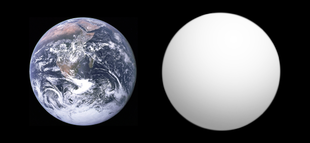Kepler-186f
|
Exoplanet Kepler-186f |
|
|---|---|
| Approximate size of Kepler-186f (right) compared to Earth | |
| Constellation | swan |
| Position equinox : J2000.0 |
|
| Right ascension | 19h 54m 36.65s |
| declination | + 43 ° 57 ′ 18.1 ″ |
| Orbit data | |
| Central star | Kepler-186 |
| Major semi-axis | 0.432 +0.171−0.053 AE |
| eccentricity | > 0.04 +0.07−0.04 |
| Period of circulation | 129.9441 +0.0013−0.0012 d |
| Further data | |
| radius | 1.11 +0.14−0.13 R ♁ |
| distance | 151 ± 18 pc |
| history | |
| Date of discovery | 2014 |
| Catalog names | |
| KOI-571.05, Kepler-186 f, KOI-571 f, K00571.05, 2MASS J19543665 + 4357180 f, KIC 8120608 f, WISE J195436.65 + 435717.9 f | |
Kepler-186f (or: Kepler-186 f ) is an exoplanet discovered in 2014 at a distance of around 490 light years from Earth . It orbits the red dwarf Kepler-186 of the spectral class M in the constellation Cygnus (swan) . Its orbit is in a habitable zone .
discovery
The planet was discovered with the help of the Kepler space telescope. This telescope recorded fluctuations in brightness that occur when a planet passes exactly in front of its central star when viewed from Earth (see transit method ). Its discovery caused a sensation, as it is very likely the first Earth-like exoplanet to lie in a habitable zone. Observation data from the Keck and Gemini observatories confirmed the discovery by ruling out 186 background stars positioned close to Kepler as possible sources of error for the decisive measured values.
properties
With a radius of 1.11 ± 0.14 Earth radii, the planet is about the size of Earth or slightly larger. This makes the assumption plausible that it is an earth-like planet (rock planet), not a gas planet . Kepler-186f orbits its central star at a distance of about 52 million kilometers and needs 130 earth days for one orbit. Although its distance to the central star is significantly smaller than that from the earth to the sun , it receives less energy due to the lower radiation from Kepler-186 (compared to the sun) and is probably on the outer edge of the habitable zone. Under the assumption of an atmospheric greenhouse effect with 0.5–5 bar CO 2 , potentially life-friendly temperatures (> 0 ° C) could still prevail on its surface.
Kepler-186f has an Earth Similarity Index (ESI) of 0.61.
Web links
- Kepler Mission - NASA (accessed April 17, 2014)
- Kepler - Discoveries - Summary Table - NASA (accessed April 17, 2014)
- Planet Kepler-186f in the Extrasolar Planets Encyclopaedia
Individual evidence
- ↑ a b c Elisa V. Quintana, Thomas Barclay, Jason F. Rowe [u. a.]: An Earth-Sized Planet in the Habitable Zone of a Cool Star . In: Science . April 18, 2014, Vol. 344, No. 6181, pp. 277–280, DOI: 10.1126 / science.1249403 .
- ↑ a b c d NASA Exoplanet Archives: Kepler-186. Retrieved May 6, 2015 .
- ↑ Michele Johnson (Ames Research Center, Moffett Field, Calif.), JD Harrington (Headquarters, Washington): NASA's Kepler Discovers First Earth-Size Planet In The 'Habitable Zone' of Another Star. nasa.gov, April 17, 2014, accessed May 4, 2015 .
- ↑ space.com: Found! First Earth-Size Planet That Could Support Life
- ↑ Spiegel.de: Exoplanet Kepler-186f: Earth twin discovered in a life-friendly zone
- ↑ First Potentially Habitable Earth-Sized Planet Confirmed by Keck and Gemini Observatories ( Memento of the original from April 18, 2014 in the Internet Archive ) Info: The archive link has been inserted automatically and has not yet been checked. Please check the original and archive link according to the instructions and then remove this notice. keckobservatory.org, accessed April 18, 2014
- ↑ Emeline Bolmont, Sean N. Raymond, Philip of Paris, Franck Selsis, Franck Hersant, Elisa V. Quintana, Thomas Barclay: formation, tidal evolution and habitability of the Kepler-186 system . In: arXiv (Ed.): Earth and Planetary Astrophysics . 1404, Submitted 16 April 2014, p. 4368. arxiv : 1404.4368 . bibcode : 2014arXiv1404.4368B .
- ↑ Bernhard Häck: HEC: Data of Potential Habitable Worlds. Planetary Habitability Laboratory (PHL), May 6, 2015, accessed May 6, 2015 .

